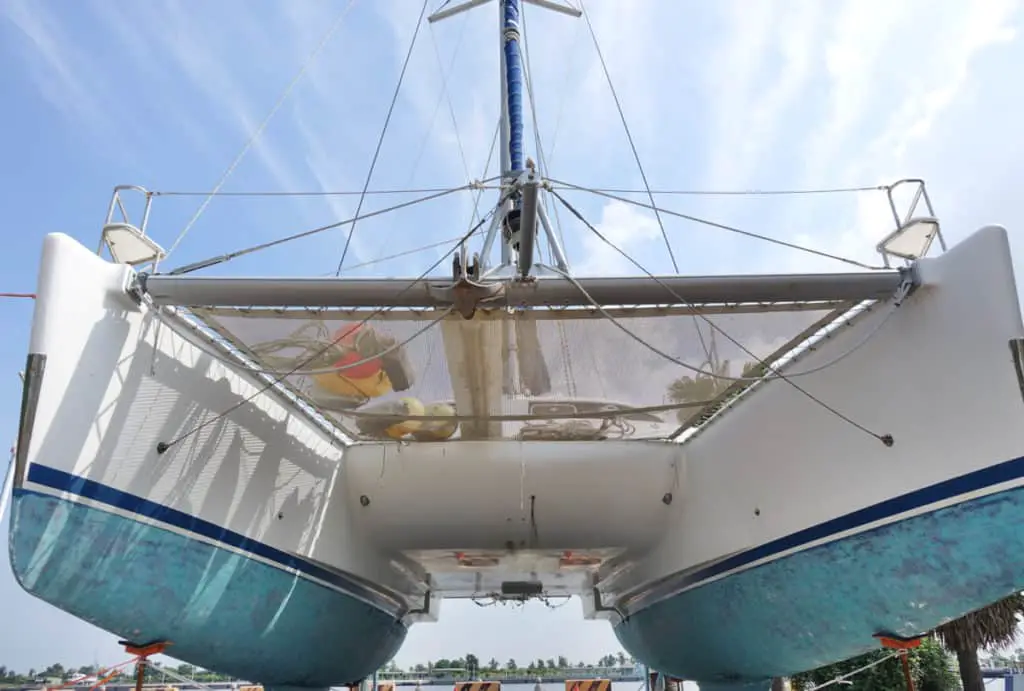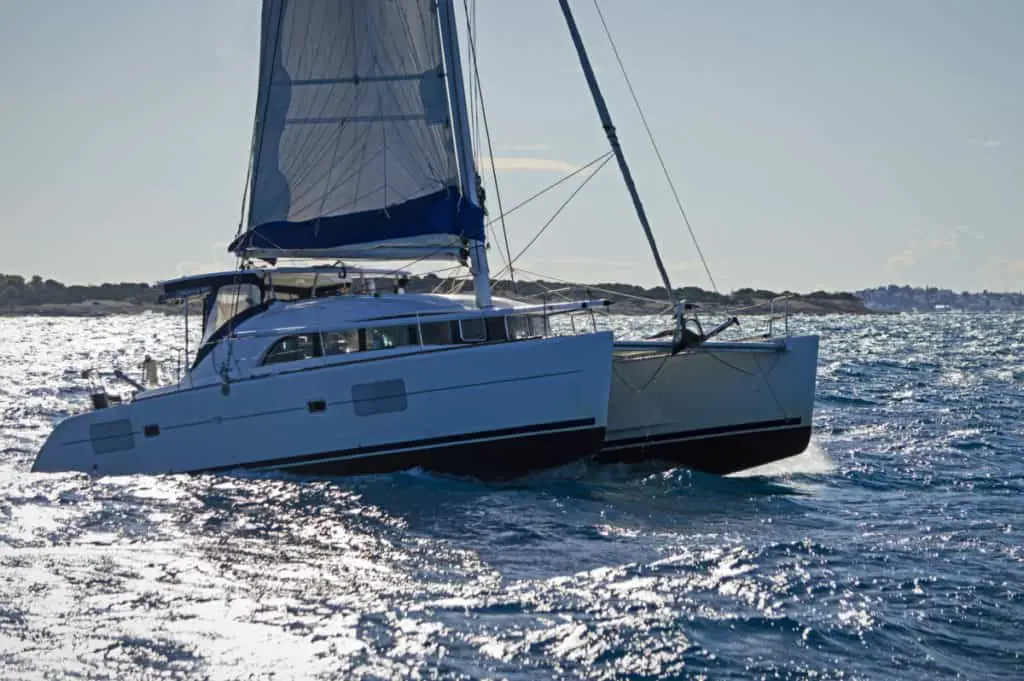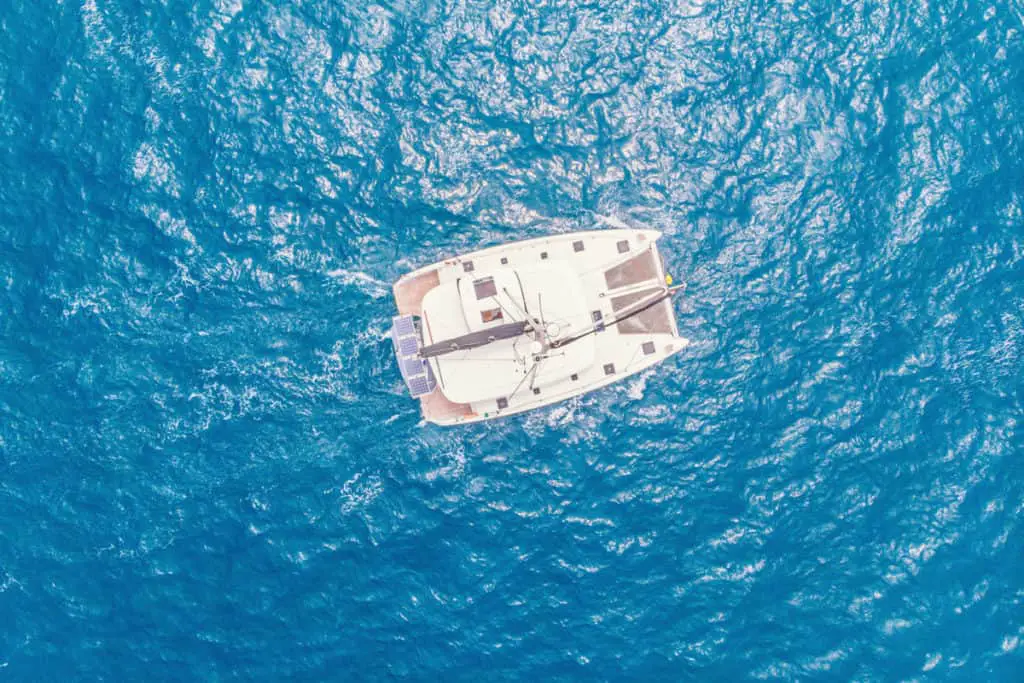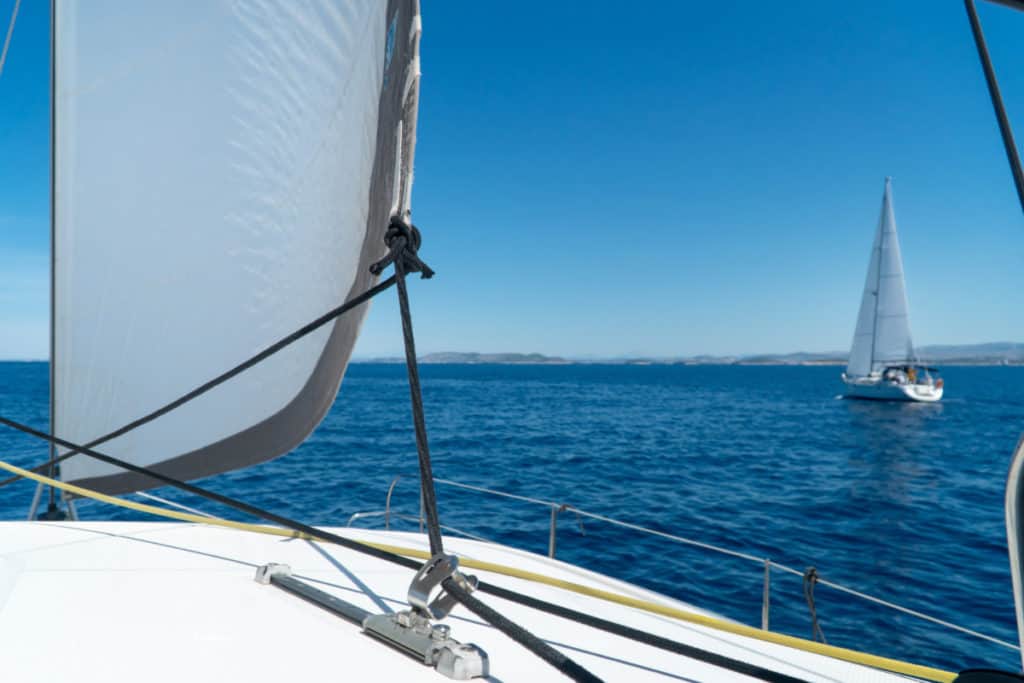As an Amazon Associate, we earn from qualifying purchases. We may also earn commissions if you purchase products from other retailers after clicking on a link from our site.
I had my first “real” sailing experience 11 years ago on a monohull in the Bahamas, before that I worked at a Ferrari workshop. Coming from a “dry-land-racing” world made me wonder why some would argue that cats are unsafe in rough seas. They should be more stable since they have a wider base, just as in the racing world, right? A few years later I still hear this old statement that catamarans arent safe for rough weather, so today ill try to add some info on the topic.
Catamarans are safe in rough seas because their double-hull design and wide stance make them highly stable. They’re also easy to maneuver, have shallow drafts, and high speeds that help them outrun storms. Still, you need a skilled crew capable of controlling the vessel to ensure your safety.
In this article, we’ll explore several reasons why catamarans are safe in rough seas. We will also take a deeper look at what makes catamarans capable of handling rough sea conditions. Keep it here to discover valuable tips on how to sail your catamaran safely despite the weather.
Catamarans Are Practically Unsinkable
A capsized monohull might right itself up, but guess what? A well-designed cruising catamaran is very hard to capsize and almost impossible to sink. This doesn’t mean that it’s okay to go looking for storms to conquer, though. So, what makes a catamaran so difficult to sink, even in the unlikely event that it flips over? Let’s find out.
If you want to dive a little deeper into Catamaran capsize statistics I suggest my other article: Why catamarans capsize!
Catamarans Are Highly Stable
In rough seas, a catamaran will show its superior performance through its twin hulls. Rough seas are defined as waves that rise to heights between 2 to 6 feet (0.6 -1.8 meters).
The hulls turn a catamaran into a floating platform that’s pretty sturdy. In addition, their wide stance and solid construction make the vessel extremely stable, allowing it to withstand the water’s constant pounding motion. The larger the boat, the more stable it gets.
The result is a smooth ride with minimal to no rocking from wave action. As a result, you are less likely to suffer from motion sickness on board a catamaran. A stable platform means reefing and sail changes become much easier and safer, particularly during rough weather. You suffer less fatigue and are thus more alert. Furthermore, there is minimal risk of anyone suffering severe injuries or falling overboard.
Cats Are Easy To Maneuver
Catamarans manufacturers employ various design and structural techniques to enhance maneuverability. Firstly, the bridgedeck positioning is above the water to create a high bridgedeck clearance, which contributes to a ride that is free from loud noises called bridgedeck slamming. Something that old school cats had problems with and would prematurely fatigue the crew.
Read this article to understand what makes a great blue water catamaran (a cat that’s design for rough seas)!
Secondly, catamarans are lightweight vessels, making it easier to steer and control them. Therefore, if you get caught up in rough weather, you are more likely to be able to handle the waves correctly and safely.
In addition to the double hulls, cats also have dual engines, making it easier to maneuver the vessel in and out of tight spots. This feature is particularly useful when you need to escape an oncoming storm and find shelter in a crowded marina. What’s more, if one engine fails as you try to outrun a storm, you can always rely on the second engine to get you to safety.
As mentioned earlier, an alert crew is essential for vessel safety in all weather conditions. And since catamarans are easy to maneuver, crew fatigue becomes a lesser issue, allowing you to sail from rough seas to safety.
It’s also easy to learn how to sail a catamaran, even as a new sailor. As a result, you will be more comfortable with your boat, promoting more straightforward navigation in rough waters.
How long does it take to learn to sail a catamaran? Check this out!
And if you want to get started right away I suggest signing up for two free lessons with NauticEd

Catamarans Have Less Draft
Because catamarans rely on the buoyancy from their twin narrow hulls (instead of one wide hull on a monohull), they can handle a shallow draft without hampering either their stability or maneuverability. Cats also spread their weight equally between the twin hulls, which allows them to sit much higher on the water.
A shallow draft means a catamaran has more shelter options when bad weather is imminent. You can also anchor your boat much closer to the shore where it’s relatively safe.
You can actually park your cat on the beach, something that is referred to as “beaching“.
They Are Incredibly Spacious
You might be wondering how ample space has anything to do with safety in rough seas. Let me explain. Catamaran layouts are well-thought-out, with spacious rooms being a major consideration. As a result, most areas, including the cockpit, main saloon, accommodation quarters, and galley, are exceptionally cozy. This enhances sailing comfort and also allows for 360-degree saloon views, which greatly improves visibility for the helmsman.
Another benefit is that there’s ample storage space, and all the sailing gear and equipment have a home. So, your gear is well-organized and stowed away carefully without crowding every available space. In rough seas, it helps the crew and anyone else on board avoid potential injuries from flying gear.
A large storage capacity also means larger fuel supplies. This is important, especially during rough weather as the engines work harder to motor through the strong currents hence they require more fuel.
Catamarans Do Not Heel
As mentioned earlier, ocean waves don’t affect catamarans as much as monohulls because, unlike monohulls, these boats don’t heel or roll (or at least not as much). This is why it’s easy to take a stroll either on the catamaran deck while under sail. The lack of heeling also makes it easier to handle the boat.
Still, due to the wide bridge deck fastened between two hulls, heavier seas could generate slapping or pounding sounds while underway (see bridgedeck clearance).
Check this article out to understand bridgedeck clearance!

Catamarans Have High Speeds
The best way to keep your vessel safe is to avoid bad weather. But this is not always possible as you could still get caught up in a storm – despite the availability of weather reports. Fortunately, because catamarans are light, they deliver impressive speeds that you can count on at such times.
Fast speeds mean you can escape rough seas by outrunning storms and bad weather.
Cruising cats attain an average speed of 9 knots (10.5mph) while sport cruising cats can reach upwards of 30 knots ( 35mph). Also, performance cruising catamarans boast narrow waterline beams, generous sail plans, and centerboards that make them sail way faster than average cats.
Which Is Safer in a Storm; Catamaran or Monohull?
If comparing similar-sized vessels, a catamaran is much safer in rough seas and storms than a monohull.
This is due to several reasons:
- Catamarans have a larger platform: Because of its large and wide base, a catamaran is more stable and can withstand pounding waves much better than a monohull.
- Catamarans are faster. You are more likely to outrun rough weather in a cat than a monohull since its design enables it to sail much faster. Besides, the higher speed allows you to cover extensive distances in minimal time. This enables you to navigate through heavy sea conditions waters much more quickly or evade them altogether.
- Catamarans are easier to maneuver. Double engines make it easier to maneuver a catamaran in and out of tight spots, such as when getting into a marina or steering across small inland waterways. Monohulls, on the other hand, have only one engine, which could lead to trouble in case of engine failure during a storm.
- Catamarans have less draft. As mentioned earlier, a catamaran will sit much higher on the water than a monohull hence it can sail with ease on shallow waters. During a storm, it has more shelter opportunities and can pull anchor closer to the beach and away from the rough seas.
- Catamarans are not likely to sink. While a capsized monohull would right itself owing to its lead keel, a catamaran wouldn’t. Nonetheless, because of the positive buoyancy, a capsized cat would not sink, which isn’t the case for a monohull. The crew in a capsized catamaran can therefore wait for help onboard the floating vessel.
Are Catamarans Safe for Ocean Crossing?
Catamarans are sea-worthy vessels capable of making long sea passages. Larger catamarans are exceptionally safe for ocean crossing since they have lots of buoyancy and great roll inertia. They can sail through fairly uncomfortable conditions and handle strong winds without taking much of a beating.
Furthermore, the boats are not likely to capsize even when breaking waves hit them as these merely cause them to surf sideways.
Lastly, a cat’s ample storage capacity also means that it can carry enough fuel, water, and food for the passage. Hence, you need not worry about running out of your supplies in the middle of the ocean.

Do All Catamarans Perform the Same Way in Rough Seas?
Depending on catamaran design, performance will vary, a small boat (below 40ft) will be slower and react more to waves, a larger catamaran (+45ft) will move faster and be less impacted by heavy seas and strong winds.
In general, a vessel’s seaworthiness boils down to the construction quality, seamanship level, and boat design.
Nonetheless, high-performance cruising cats can sail windward faster than the best keelboats. Featuring efficient daggerboards, deep rudders, plus less displacement and windage, they deliver a good performance windward in all kinds of weather.
And since these catamarans are light in weight and contain ample sail plans, you need to pay special attention to your sail choice to maintain safety in all weather conditions.
But not all catamarans behave like high-performance cruising catamarans. Therefore, you need to have a deep understanding of how your boat operates before you set off into the open sea. This is only accomplished through spending time on the water.
Tips on How To Sail Safely in Rough Seas
There are fundamental safety measures as well as storm tactics. These are essential when sailing in any weather, but more so if you get caught up in rough seas.
- Undergo training. Get sufficient training on basic sailing and what to do in the event of an incident at sea. Basic safety drills are also important, and all crew should know the specific location of all life-saving equipment.
- Find out details about the expected weather. Make sure you are able to get updates while under sail, either through satellite or mobile network.
- Have the right protective equipment. Always have protective gear on board, including life jackets and vests, close at hand. Set up the boat with the appropriate safety lines and attach yourself to the same. Crew members should carry a knife, strobe, and whistle as well.
- Avoid putting your catamaran on the direct path of breaking waves (beam reach). Instead, opt for a course that places both the wind and high waves either ahead or behind the beam. Minimize the chances of a wave crashing across the deck by tacking in relatively smooth water.
- Park your catamaran. If the storm gets too intense, consider parking (heaving-to) your cat. This will give the boat some break from the windward pounding.
The specific storm strategies you need to use will crucially depend on the condition of the sea.
I would recommend you read the book Multihull seamanship (amazon link), the graphics are lame but the book is very informational, it walks you through procedures such as heave-to and what to do in case of emergency.
For additional tips on how to maintain the safety of your catamaran in rough seas, watch the video below:
Frequently Asked Questions
Should I Run My Catamaran Straight Downwind or Angle It Away From the Waves?
It’s better to run downwind but at a slight angle since this will help increase the effective catamaran length by offering its diagonal distance to the following seas. The slight angle allows the bows to bury less, keeps the hull stable, reduces the risk of pitchpoling, and also makes it much easier to follow the sea.
How Much Sail Should I Use in Rough Seas?
When facing rough conditions it’s best to go with a minimal sail area (such as a storm jib). Minimal sail helps to calm the vessel, which makes autopiloting relatively easier. This means that you might not need to handle the helm, leaving the autopilot to do its work.

Does a Catamaran’s Length Affect Its Ability To Survive Rough Seas?
Yes, it does. A catamaran with a long waterline handles high winds and towering waves better than a small cat. The easier motion facilitates crew maneuvers, while the high boat weight increases resistance to tossing and rolling caused by the wind and waves. In addition, the higher speed helps in running from the storm.
What´s the perfect size cat for ocean sailing?
What Can Cause a Catamaran to Capsize?
A huge wave to the catamaran’s beam or surfing down a wave and burying the bows in the next wave, making it frontflip or pitchpole. To better understand catamaran capsize I suggest you read my scientific approach to understanding capsizing here.
Final Thoughts
Sailing in rough seas is a true test of seamanship. I used to be afraid of the seas, now it has become my friend. Maybe it will be the same for you! Take care!

